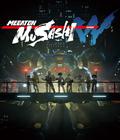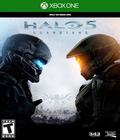Editor's Note: Last week, we took a look at Halo 5's single-player campaign. Now that the game has been out and live on retail servers, the verdict is in on the multiplayer aspect. It's even better than the single-player experience.
Halo 5's multiplayer consists of co-op campaign support as well as traditional multiplayer. Playing through the campaign levels in co-op is the same as playing through them in single-player, except your AI buddies are replaced with real, live humans. If you can assemble a fire team of four, you're pretty much good to go, even on Legendary difficulty.
Co-op gives you a distinct advantage in campaign for one simple reason: Human players move around intelligently. While the AI is good at reviving you if you should fall in battle, it doesn't have any sense of tactics. As I mentioned in the single-player review, going up against the Warden with AI buddies can be an exercise in frustration. With human partners, taking out the boss monster is more direct, especially since one person can run a diversion tactic while the others attack.
The only real downside to co-op is the fact that it cannot be played split-screen on the same console. If you want to play with friends, every player needs to have his or her own system.
On the competitive front, you have Arena and Warzone. Arena consists of the traditional multiplayer modes, from standard deathmatch to capture the flag and the new eSports-oriented Breakout. Arena modes are split up into playlists, so if you jump into matchmaking, you're only going to play what's currently in rotation. For example, during the first week of play, Breakout was available in the Breakout playlist, but it was also showing up in the Team Arena playlist. If you want to play something that isn't in an active playlist, you'll need to set up a custom game.
After playing 10 games in a playlist, the server awards you a rank based on your skill level. This is supposed to be used to further improve matchmaking, so novice players aren't facing off against experts. For the most part, matchmaking seemed to work well, though there were a handful of matches where a single player dominated the entire time. As time goes on, matchmaking quality should improve.
Aside from the minor matchmaking quibbles, actual online play was solid. Lag was never an issue. Over the course of the past week, I only had one instance of characters suddenly warping across the screen. Shots seemed to hit their marks, and deaths were usually chalked up to skill — or lack thereof.
One way to help improve your game is to use the theater mode and the spectate function. Theater mode allows you to load up replays of your recent games and watch them from any viewpoint. Dedicated players can use this as a means to identify what they did wrong, as well as analyze the strategies used by their opponents. Spectating is similar to theater mode, except you are watching another player on a slight delay.
Oddly, spectating is not an option in the main menu. You need to select a player from your friend list or the recent players list and then choose the spectate option. This is a good way to learn tactics from better players. Just kick back and watch the action unfold.
Whereas Arena is designed around the competitive Halo player, the new Warzone mode is designed for the mass market. Best described as the "big battle" mode, Warzone supports matchups of up to 24 players, with 12 players per team. The default Warzone mode has both teams fighting for control of three bases as they attempt to rack up points by killing each other and taking out AI-controlled enemies. A win can also be achieved by destroying the enemy team's base. Warzone Assault is an asymmetric variant, with one team attacking and the other defending.
Personally, Warzone was the big draw for me and the reason I'll keep coming back to Halo 5 as the months pass. The large number of players means that the unexpected is bound to happen, especially when both teams are trying to take out the same AI enemy. There is a focus on the AI-controlled enemies because they are worth a number of points but also because the points are awarded based on a "last hit" model. That means each spawn is a chance for the losing side to catch up. You don't need to take out an AI enemy by yourself. You just need to land the kill shot. Stealing a kill (and the associated points) from the opposing team is extremely rewarding.
Unlike Arena, where power weapons are found on the field, Warzone ties power weapons and vehicles to Halo 5's REQ system. REQ points are awarded for playing the game and can be spent on REQ card packs, which contain player cosmetic items (usable in both Arena and Warzone) as well as power weapons and vehicles (Warzone only).
What makes the REQ card system interesting is the fact that the power weapon and vehicle cards that you use in Warzone are all single use. Once a card has been used, it is removed from your inventory. This means you have to be smart about when you want to use something. If you spawn with a power weapon and immediately die, there was no benefit to using the card. Incidentally, you can steal power weapons and vehicles from opposing players simply by killing them in battle. This doesn't grant you the card, but you can use whatever items were dropped.
Because of the desire to best use your cards, Warzone naturally encourages team play. After all, one player spawning a tank might not be a huge threat, but if half a team suddenly spawns tanks, then you suddenly have a formidable force on the battlefield.
Initially, you might want to save your cards for a later match "just in case," but you really shouldn't hold back. Halo 5 is pretty liberal with REQ points, which means you shouldn't have any trouble buying packs with in-game currency. Yes, you can spend real money on them if you want to, but doing so is a waste since active players are never short on REQ points.
If anything, the only aspect of the REQ system that I would change would be to add the ability to buy, sell and trade the REQ cards that you don't want in-game. Right now, your only options for a REQ card are use it or sell it back to the store. Being able to trade with other players would be a big plus.
In the end, Halo 5's multiplayer offers up a little something for everyone. Competitive players have Arena and its traditional rule sets, casual players have the pick-up-and-play battles of Warzone, and groups of friends have co-op campaign. All of the online modes are solid, and it's very easy to spend hours shooting virtual guns at other people.
Halo 5's single-player campaign is fun, but the game is at its best when you're coordinating with others and attacking objectives as a team.
Score: 8.9/10
More articles about Halo 5: Guardians











 Halo 5: Guardians is the next installment in the saga of the Master Chief, with more content, and larger in scope than its predecessor, built from the ground up with a brand new and more powerful engine.
Halo 5: Guardians is the next installment in the saga of the Master Chief, with more content, and larger in scope than its predecessor, built from the ground up with a brand new and more powerful engine.














































